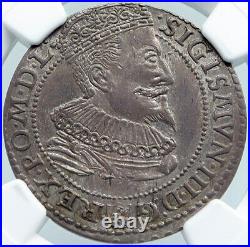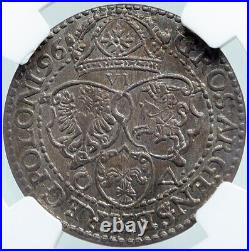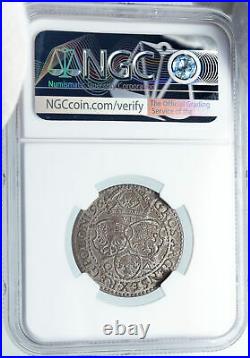





Item: i87858 Authentic Coin of. Marienburg Sigismund III – King: 18 September 1587 – 19 April 1632 1596 Silver 6 Groschen 29mm (6.19 grams) Reference: KM# 42 Certification: NGC. MS 61 5846613-005 SIGISIII. D:L, Crowned bust of Sigismund III right. Three shields, Coat-of-arms within each, crown atop. Sigismund III Vasa Polish: Zygmunt III Waza , Swedish: Sigismund , Lithuanian: ygimantas Vaza ; 20 June 1566 – 30 April 1632 N. , also known as Sigismund III of Poland , was King of Poland, Grand Duke of Lithuania and monarch of the united Polish-Lithuanian Commonwealth from 1587 to 1632 as well as King of Sweden and Grand Duke of Finland from 1592 until his deposition in 1599. Sigismund was the son of John III of Sweden and his first wife, Catherine Jagiellon of Poland. Elected to the throne of the Polish-Lithuanian Commonwealth, he sought to create a personal union between the Commonwealth and Sweden (Polish-Swedish union), and succeeded for a time in 1592. After he had been deposed in 1599 from the Swedish throne by his Protestant uncle, Charles IX of Sweden, and a meeting of the Riksens ständer, he spent much of the rest of his life attempting to reclaim it. A pious yet erratic ruler, Sigismund attempted to hold absolute power in all his dominions. Shortly after his victory over internal opposition, Sigismund took advantage of a period of civil unrest in Muscovy, known as the Time of Troubles, and invaded Russia, holding Moscow for two years (1610-12) and Smolensk thereafter. In 1617 the Polish-Swedish conflict, which had been interrupted by an armistice in 1611, broke out again. While Sigismund’s army was also fighting Ottoman forces in Moldavia (1617-21), King Gustavus II Adolphus of Sweden invaded Sigismund’s lands, capturing Riga in 1621 and seizing almost all of Polish Livonia. Sigismund, who concluded the Truce of Altmark with Sweden in 1629, never regained the Swedish crown. His Swedish wars resulted, moreover, in Poland’s loss of northern Livonian territories and in a diminution of the kingdom’s international prestige. Sigismund remains a highly controversial figure in Poland. One of the country’s most recognizable monarchs, he transferred the capital from Kraków to Warsaw in 1596 and his long reign coincided with the apex of the Polish-Lithuanian Commonwealth’s prestige, power and economic influence. On the other hand, it was during his reign that the symptoms of decline leading to the Commonwealth’s eventual demise surfaced. Popular histories, such as the books of Pawe Jasienica, tend to present Sigismund as the principal source of these destructive processes; whereas academic histories are usually not as damning of him. However, the question of whether the Commonwealth’s decline was caused by Sigismund’s decisions or had its roots in historical processes beyond his personal control remains highly debatable. He was commemorated in Warsaw with Sigismund’s Column, one of the city’s landmarks and the first secular monument in the form of a column in modern history. It was commissioned after Sigismund’s death by his son and successor, Wadysaw IV. Poland , officially the Republic of Poland , is a country in Central Europe, bordered by Germany to the west; the Czech Republic and Slovakia to the south; Ukraine and Belarus to the east; and the Baltic Sea, Kaliningrad Oblast (a Russian exclave) and Lithuania to the north. The total area of Poland is 312,679 square kilometres (120,726 sq mi), making it the 69th largest country in the world and the 9th largest in Europe. With a population of over 38.5 million people, Poland is the 34th most populous country in the world, the 8th most populous country in Europe and the sixth most populous member of the European Union, as well as the most populous post-communist member of the European Union. Poland is a unitary state divided into 16 administrative subdivisions. The establishment of a Polish state can be traced back to 966, when Mieszko I, ruler of a territory roughly coextensive with that of present-day Poland, converted to Christianity. The Kingdom of Poland was founded in 1025, and in 1569 it cemented a longstanding political association with the Grand Duchy of Lithuania by signing the Union of Lublin. This union formed the Polish-Lithuanian Commonwealth, one of the largest and most populous countries of 16th and 17th-century Europe. Poland regained its independence (as the Second Polish Republic) at the end of World War I, in 1918. In September 1939, World War II started with the invasions of Poland by Nazi Germany and the Soviet Union (as part of the Molotov-Ribbentrop Pact). More than six million Polish citizens died in the war. In 1944, a Soviet-backed Polish Committee of National Liberation was formed which, after a falsified referendum in 1947 took control of the country and Poland became a satellite state of the Soviet Union, as People’s Republic of Poland. During the Revolutions of 1989 Poland’s Communist government was overthrown and Poland adopted a new constitution establishing itself as a democracy. Despite the large number of casualties and destruction the country experienced during World War II, Poland managed to preserve much of its cultural wealth. There are 14 heritage sites inscribed on the UNESCO World Heritage and 54 Historical Monuments and many objects of cultural heritage in Poland. Since the beginning of the transition to a primarily market-based economy that took place in the early 1990s, Poland has achieved a “very high” ranking on the Human Development Index, as well as gradually improving economic freedom. Poland is a democratic country with an advanced high-income economy, a high quality of life and a very high standard of living. Moreover, the country is visited by nearly 16 million tourists every year (2013), which makes it one of the most visited countries in the world. Poland is the sixth largest economy in the European Union and among the fastest rising economic states in the world. Furthermore, according to the Global Peace Index for 2014, Poland is one of the safest countries in the world to live in. World-renowned expert numismatist, enthusiast, author and dealer in authentic ancient Greek, ancient Roman, ancient Byzantine, world coins & more. Ilya Zlobin is an independent individual who has a passion for coin collecting, research and understanding the importance of the historical context and significance all coins and objects represent. Send me a message about this and I can update your invoice should you want this method. Getting your order to you, quickly and securely is a top priority and is taken seriously here. Great care is taken in packaging and mailing every item securely and quickly. What is a certificate of authenticity and what guarantees do you give that the item is authentic? You will be very happy with what you get with the COA; a professional presentation of the coin, with all of the relevant information and a picture of the coin you saw in the listing. Additionally, the coin is inside it’s own protective coin flip (holder), with a 2×2 inch description of the coin matching the individual number on the COA. Whether your goal is to collect or give the item as a gift, coins presented like this could be more prized and valued higher than items that were not given such care and attention to. When should I leave feedback? Please don’t leave any negative feedbacks, as it happens sometimes that people rush to leave feedback before letting sufficient time for their order to arrive. The matter of fact is that any issues can be resolved, as reputation is most important to me. My goal is to provide superior products and quality of service. How and where do I learn more about collecting ancient coins? Visit the Guide on How to Use My Store. For on an overview about using my store, with additional information and links to all other parts of my store which may include educational information on topics you are looking for. The item “1596 POLAND DANZIG King Sigismund III ANTIQUE Silver 6 Groszy Coin NGC i87858″ is in sale since Wednesday, January 20, 2021. This item is in the category “Coins & Paper Money\Coins\ World\Europe\Poland”. The seller is “highrating_lowprice” and is located in Rego Park, New York. This item can be shipped worldwide.
- Country/Region of Manufacture: Poland
- Certification Number: 5846613-005
- Certification: NGC
- Geographic Origin: Poland
- Grade: MS 61
- Year: 1596
- Composition: Silver
- Denomination: 6 Groszy

